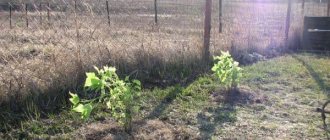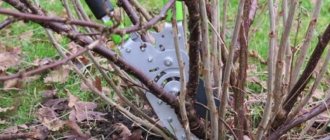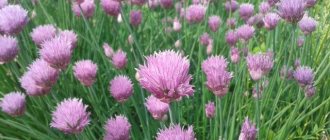Why do raspberries grow all over the garden?
The main reason that raspberries spread throughout the entire area is the special structure of its root system. The rhizomes divide and spread throughout the garden bed, producing new shoots. When weeding an area irregularly, the plant tends to fill the entire area of the area.
Fighting overgrowth is painstaking and long work, and can last throughout the summer. Therefore, it is better to take measures from the very beginning that will not allow the plant to occupy the entire garden.
Benefits of using trellises for growing raspberries
A garter for raspberries is necessary, since the bush is tall - 1.5-1.8 m. At the same time, the shoots of the plant are relatively thin and flexible, and therefore they bend and often cannot support their own weight. A large harvest causes the branches to sink to the ground, causing the berries to become sick and rot.
Only low-growing raspberry bushes can do without a garter. For early ripening and high-yielding varieties, this procedure is simply necessary. In general, a trellis for blackberries and raspberries is very useful; this design has many advantages:
Thanks to trellises, raspberry bushes look neater and it’s easier to move between them
- Thanks to trellises, you can easily form beautiful rows of raspberries.
- The lower branches of the plant do not get dirty because they do not touch the ground. As a result, the stems, leaves and berries are not attacked by pests such as snails and frogs.
- The berries, regardless of the weather, remain clean.
- Thanks to trellises, raspberry bushes form regular straight beds with wide spaces between them. This promotes excellent wind blowing, which guarantees dryness of the bushes, and therefore prevents fungal diseases.
- Using a trellis ensures that the raspberries are planted evenly, resulting in each branch receiving equal lighting. This promotes simultaneous ripening of the berries and simplifies harvesting.
- It is easier for a gardener to care for plants. Watering, weeding and mulching the soil is very easy to do. In addition, the use of such planting allows you to see and eliminate damaged shoots in time.
- It’s easier to harvest and then prepare the area for winter.
- It's easier to move between bushes. Without trellises you will have to make your way through dense thickets.
If the raspberries are tied to a trellis, it is easier to care for them, water them and weed them
In order to get all the benefits, it is important to select and install the trellis structure correctly.
Helpful advice! The base of the trellis should be buried 80-100 cm into the ground, so the total length of the pole should be about 230-280 cm: 80-100 cm in the ground and 150-180 cm above it.
How to plant berries so that they do not grow?
To prevent raspberries from spreading throughout the garden, they must be planted correctly, taking into account all the characteristics of the crop.
Site selection
An excellent harvest is only achieved if a suitable site has been chosen from the very beginning. The following requirements apply to it:
- humidity is moderate, since roots rot in very wet soil, bushes are often planted in areas with a slight slope;
- illumination is good, bushes bear fruit poorly in the shade;
- soil - loose, medium acidity, enriched with nutrients;
- the location of the rows is from north to south or from northeast to southwest, which is especially important in the middle zone.
If several rows of raspberries are planted, then leave a distance of 1.5 m between them, and at least 60 cm between the bushes.
The site is chosen away from buildings and garden trees. The latter will compete in the fight for nutrients and moisture, which will negatively affect the harvest.
Fragile branches are afraid of drafts and, bending in gusts of wind, can break. Wind protection is installed in a blown area, but in such a way that it does not shade the bushes.
When to plant?
Raspberries can be planted from spring to autumn. Planting time in most cases is determined by the climate zone:
- south: end of September - first weeks of October. The bushes have time to take root before the onset of frost. In spring, planting is undesirable, since in these regions it quickly warms up, the buds immediately open on the plants, and the bush does not have time to take root properly;
- north: spring here is long and wet. Planting immediately after the soil thaws promotes plant survival. Autumn seedlings often freeze out;
- middle zone: any time of year is suitable, except winter. Autumn planting is preferable if snow is forecast early. During late snowfalls, seedlings may freeze. But it is better to transfer weakly winter-hardy varieties to the garden bed in the spring.
Reference. It is best to plant raspberries in plots after dill, beets, carrots, calendula, onions, garlic, and beans. It is useful to grow lupine in the previous year, which helps remove cockchafer larvae from the soil, which pose a danger to raspberries.
Acidity level, methods of determination
The range of plant tolerance to soil pH is very diverse. Some are very sensitive to even the slightest changes in acidity, others do better in alkaline soils. One thing is certain: soils with extreme reactions are not conducive to growing any plants.
Determining the pH of the soil is not easy, but it is necessary in order to obtain maximum yields and properly use the soil's potential.
Electrometric or colorimetric methods can be used for this purpose. Did you know? Raspberries are a plant that is grown in different climatic zones and has hundreds of different varieties. There are bushes with yellow, black and red fruits, with thorns and without thorns.
A neutral pH of 6.6 to 7.2 is suitable for most plants. Acidic soils have a lower value, and we can talk about a very acidic reaction, starting from a value of 4.5. An alkaline reaction is considered if the acidity is above 7.2; usually such indicators occur when the soil contains carbonate elements.
Tester device
Analysis using a special device is carried out by measuring the difference in indicators (actual and reference). The device consists of a measuring electrode (for immersion in the ground) and a screen on which the result of the measurement is displayed.
Litmus paper
The colorimetric method consists of comparing the color of a soil solution in combination with a suitable indicator on a reference color scale, each color of which has its own meaning. To do this, a handful of soil is mixed with a small amount of water, and litmus paper is dipped into the resulting solution. When the control segment changes color, the color is compared with the acidity palette.
However, this method may not be very accurate, and if clarification is necessary, it is worth contacting a specialized laboratory where they will conduct a chemical analysis of the soil composition.
Natural indicator
Not all plants tolerate even small deviations in pH value from the neutral level. There are also those that thrive only in an acidic or alkaline environment; their presence in the garden bed can help the gardener determine the approximate level of soil acidification.
Plants of indicative acidity include: pansies, field clover, horsetail, juniper, cornflower, field daisies, etc. Acidic soils are also an ideal place for swamps; moss and ferns can often be found on them. You cannot see any of these plants in alkaline soil because they need a high concentration of hydrogen ions. In places where the pH is greater than 7.2, nettle, white nettle, field grass, poppy, spurge and St. John's wort develop well.
How to fence properly?
In order for the root system to form correctly, the bush must be fenced. Various methods are used for this.
Nitrogen fertilization
Nitrogen fertilizers - urea, ammonium nitrate - help to resist the growth of raspberry rhizomes. Fertilizing is carried out in early spring, when the buds awaken and young shoots are actively developing. Gardeners, for example, use this recipe:
- superphosphate - 60 g;
- ammonium nitrate - 30 g;
- ash - 40 g;
- water - 10 l.
The dry ingredients are dissolved in water, and the resulting mixture is poured under the root of the bushes.
How to protect?
One way to stop crop migration through a site is to install a physical barrier. To do this, you can use improvised means, construction waste. The material must be sufficiently dense, have no holes and not decompose in the soil.
How to protect growth using cellophane?
This method will require thick plastic film. Materials for waterproofing or swimming pools (for example, butyl rubber film, roofing felt) are also suitable.
The material is laid out along the edges of the trench or hole when planting a bush, the lower edges are sprinkled with earth. The depth should be at least 50 cm. The material is taken 15–20 cm wider. If it is not possible to cover the ground in one piece, the parts are glued together with tape.
Important! The films should fit tightly one to the other. If the slightest gap remains between them, the shoots of the rhizome will eventually find a weak link and penetrate outward.
Slate fencing
For this method you will need slate and a grinder. A fence for the entire row is made from asbestos-cement sheets.
Construction consists of the following stages:
- Place pegs around the bed in those places where it is planned to build a fence, and pull the thread.
- A trench 30 cm deep is dug under the established marks.
- Cut the slate sheets so that you get pieces 60 cm high.
- Lower the stretched thread level with the ground.
- Place slate sheets in the trench so that 20 cm remains from the thread to the top edge of the sheet.
- Cover the trench with earth.
Important. The sheets must be overlapped to prevent roots from penetrating through the cracks. It is better to cover the joints with film in 2-3 layers.
How to make a barrier from iron?
Iron is also a good fencing for raspberry fields. The construction algorithm is the same as when installing slate. But iron has a drawback: when immersed in the soil, it will be exposed to moisture, resulting in the formation of pockets of corrosion. Therefore, the material is first treated with water-repellent preparations - for example, liquid bitumen.
Which plants prevent overgrowth?
You can also arrange a “hedge” on the site. Some plants will prevent raspberries from growing.
For example, in the aisles you can plant:
- sorrel;
- meadow broom;
- garlic.
This method has a double benefit: you can save on materials and get a harvest of greens for the table.
Bush pruning
Young shoots are destroyed at a very early stage of development, if there is no goal to propagate raspberries. This will not only help keep the area clean, but will also give additional strength to the remaining shoots.
Thinning of overgrown raspberries is carried out in several stages:
- In the spring, with the arrival of warmth, the bushes are inspected. Remove dry, broken, poorly developed shoots, leaving only 10–15 trunks per linear meter. The remaining ones are shortened by 20-25 cm.
- In the summer, after picking the berries, two-year-old shoots are pruned to ground level. Weak young trunks up to 50 cm high, growing in groups, are regularly dug up. Only the strongest stems are left within a radius of no further than 30 cm.
- In the fall, 3 weeks before the arrival of cold weather, fruit-bearing, old, diseased and dried shoots are cut out. The shoots are dug up so that the distance between the bushes remains 60 cm or more.
Reference. Experienced gardeners recommend cutting out remontant varieties at the root in the fall. This will improve the quality of fruiting next year.
Movement and rejuvenation
The bush not only grows, but moves. An alternative technique called “movement and rejuvenation” uses this property of the crop to help keep the raspberry tree neat.
But this method has other advantages. It helps maintain the integrity of the root and the immunity of the plant, which has a positive effect on the quality of the crop. The crop gets sick less often, and the raspberry tree is constantly rejuvenated naturally without transplantation.
To grow raspberries using this technology, allocate as much space as possible on the site.
Growing consists of the following stages:
- Restrictive shields are installed along the long side of the plot and at the ends, as described above, under which a row of raspberries is planted.
- When young shoots appear, everything that is closer than 1.5 m to the mother plant is destroyed.
- A new row is formed from young bushes located further than 1.5 m.
- Repeat until the area is completely filled with raspberries.
- Restrictive sheets are buried on the opposite side.
- The old rows are gradually destroyed for 5-6 years.
Reference. Raspberries can grow in one place for up to 20 years. But this is too long a time for a full harvest. Gradually the berries become smaller and the rhizome ages. The optimal period is 10-12 years.
What should the landing hole be?
To plant raspberries, you need to dig a hole about 40 cm wide and 50 cm deep.
The distance between two bushes is 1 m.
You can add compost, rotted manure, or any organic matter (small pieces of wood, paper, plant debris, etc.) to the bottom of the hole.
When planting raspberries on organic residues, the largest and longest decomposing ones should be planted first. Alternate each layer of organic matter with a layer of soil.
If the soil is fertile, you can limit yourself to adding wood ash (1 tbsp) and superphosphate (2 tbsp) into the hole.
To make organic residues decompose faster, you can sprinkle Bokashi on top.
What to do to limit the growth of the bush?
Prevention is the main way to limit the growth of a bush. In addition, it is useful to study other gardening know-how. Many of them may be even more effective than those listed above.
Preventive measures
To prevent raspberries from growing too much, they need constant care. Prevention of clogging of the area with young growth will be:
- regular pruning of young but weak shoots;
- planting in “smart beds”, when the edges of the trench are lined with boards;
- laying paths along the raspberry tree - roots will not penetrate through the compacted soil;
- choice for planting remontant varieties that produce fewer root shoots.
Video
The video shows the simplest trellis for raspberries:
The use of intensive technologies for growing raspberries is impossible without the use of special agrotechnical devices. Trellis are an opportunity to expand the range of products grown in a limited area. If you want to increase the productivity of your raspberry garden and reduce the time it takes to care for it, install a simple structure in the form of a trellis on your berry garden. This process is labor-intensive, but it pays off with a significant increase in productivity. You may also be interested in reading about the technology for installing trellises for climbing plants with your own hands.
Plant beans and garlic
Both of these plants live well next to raspberries, restraining their growth and preventing young shoots from growing. Garlic, at the same time, also repels pests with its smell; beans, in turn, release components into the soil that inhibit the growth of raspberry rhizomes. But here’s the problem: beans have the same depressing effect on garlic. So, it’s good to plant one thing next to raspberries. If you have a large raspberry patch, you can plant beans on one edge and garlic on the other.
So, you can stop the uncontrolled growth of raspberries using improvised means and without much difficulty. However, it is important to remember that you need to use methods that will not harm the plant itself.
- Author: Inna Kiseleva
Rate this article:
- 5
- 4
- 3
- 2
- 1
(1 vote, average: 4 out of 5)
Share with your friends!
DIY trellis: selecting materials for construction
Raspberries need support already in the second year after planting. Therefore, a trellis for shoots should be installed within the first two years. It is best to place poles and anchors immediately after planting. Next spring, even before the snow has completely melted, while the poles are firmly held in the frozen soil, it is necessary to tension and secure the wire.
To make trellises, you can use reinforced concrete posts or metal pipes of small diameter
Standard reinforced concrete structures with a cross section of 10×10 cm can be used as pillars. Substandard pipes with a diameter of 8-10 cm are also suitable for these purposes. Wood can also be used.
The total length of the poles is 2.2-2.5 m, while their height above the soil surface is 1.5-1.8 m. Before installing them on a raspberry field, metal poles are treated with anti-corrosion substances, for example, immersed in a bath of bitumen, and wooden ones - with antiseptics (soaked for 2-3 days in a solution of copper sulfate). The optimal distance between posts on a plantation is 10-20 m. For 1 hectare you will need from 200 to 400 pieces.
The posts at the end of the row must be additionally secured with anchors. Stainless steel wire is perfect for tensioning between vertical supports. But it is best to use a polyethylene-coated product, polyamide wire or reinforced polyethylene (or propylene) twine.
Each shoot of the plant is tied separately. The stems can be attached to the main wire with another long thread of soft wire or twine, braiding the main thread along with the shoots. The ends of the twine are secured to the outermost posts.
Wood is great for making your own trellises
Helpful advice! When creating a double-sided trellis, the costs will be 30% higher than when creating a one-sided trellis, and 70% more than when constructing a vertical one.











